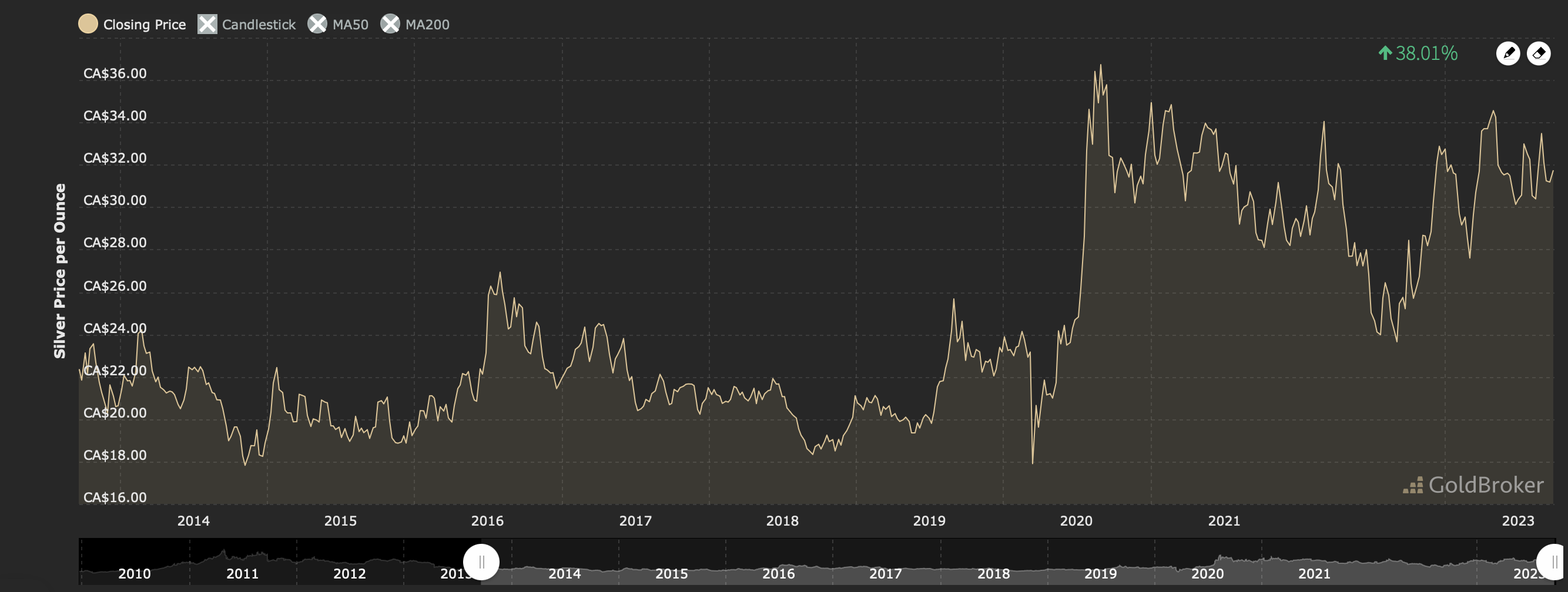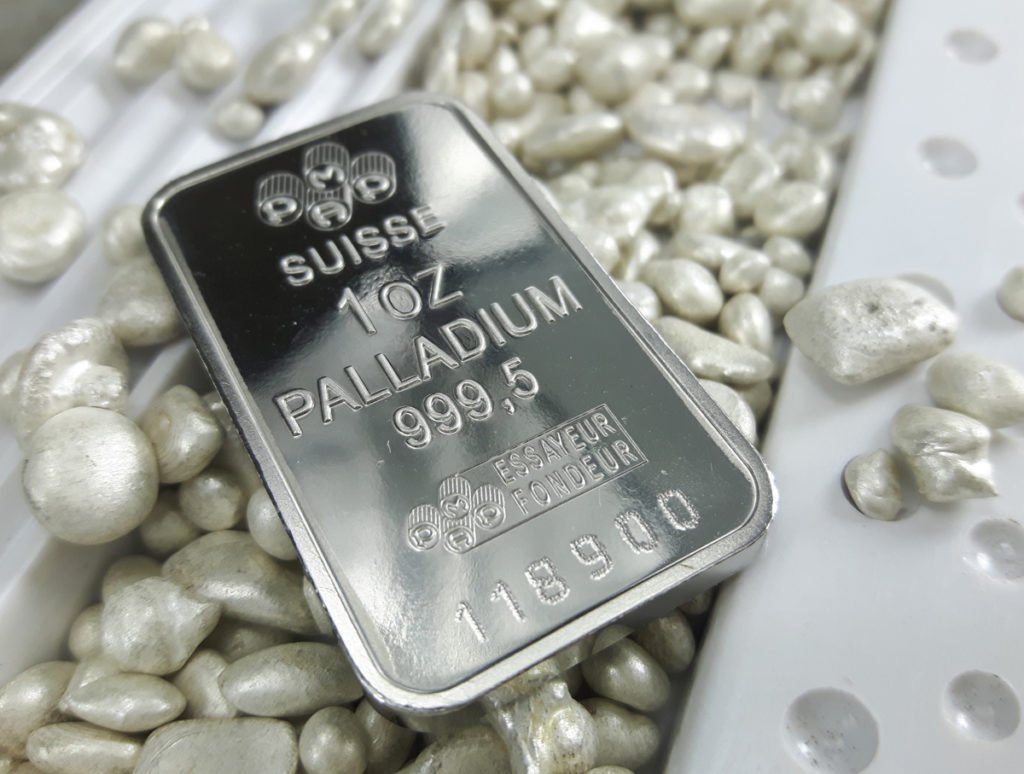
The economic uncertainty in 2023, coupled with equities reaching all-time highs, inflation remaining persistent, and the labor market showing incredible resilience despite rising interest rates, has led many investors to consider adding silver to their portfolios.
On the surface, investing in silver makes sense. Typically, when a recession is near and inflation is high, precious metals are a common safe haven for investors.
Silver prices will typically rise when stocks fall, making it a great inflation hedge and a less volatile asset that investors can use to preserve their money and avoid large losses in the stock market.
However, investing in silver is not always a great investment, and today, we will be going over why investing in silver today may be ill-advised, depending on your financial goals and risk tolerance.
More specifically, we will cover why specifically silver is not the best investment option in today’s world, as well as provide other precious metals that offer greater returns with less risk than silver.
Why Silver is a Bad Investment Explained
While silver can be a good investment option for some, there are some concerns and disadvantages investors need to be aware of.
Below, we’ve simplified the reasons why investors should reconsider investing in silver to four basic concepts:
1. Volatility:
Silver’s Unpredictable Price Swings
Silver is notorious for its price volatility, which can be a significant concern for investors. Prices of silver can experience substantial fluctuations over short time frames, driven by various factors such as economic data releases, geopolitical events, and shifts in investor sentiment. This inherent unpredictability can be unsettling for investors seeking more stable assets in their portfolios, as the value of their silver holdings may swing dramatically, potentially leading to losses.
More specifically, the chart below shows the price of silver over the last 10 years. And while right now, silver is near an all-time high, this chart shows the incredible volatility and large price drops that are common when investing in silver.

Silver Price in Canadian Dollar – Canada | Gold Broker
2. Lack of Income:
Silver Doesn’t Provide Regular Cash Flow
Unlike investments like dividend-paying stocks or bonds, silver does not generate regular income. When you own silver, your returns primarily come from price appreciation. This lack of income can pose challenges, particularly for investors who rely on their investments to provide a steady cash flow. This is particularly relevant to individuals in or near retirement who may require reliable income streams to cover living expenses.
And while silver ETFs or investing in silver companies can provide some income through dividend payments, these payments are typically sporadic and should not be relied on as a regular source of income.
3. Limited Industrial Use:
Silver’s Role in Industry and Price Dynamics
While silver has numerous industrial applications, it is not as universally utilized as other metals like copper, nickel, or lithium. Consequently, silver’s price can be influenced more by speculative trading, macroeconomic factors, and investor sentiment than by fundamental demand from industries. This can result in price movements that do not necessarily correlate with underlying supply and demand dynamics, making silver a less predictable investment.
4. Storage Costs and Security:
The Expenses of Holding Physical Silver
Investors who choose to physically own silver in the form of coins or bars need to consider the associated costs. Safeguarding silver securely can be expensive, requiring the purchase of a high-quality safe or the utilization of a secure storage facility.
Moreover, insurance costs may be necessary to protect your silver investment against theft or damage. These expenses can significantly reduce the returns on your investment, particularly for those dealing with relatively modest quantities of silver.
Silver’s price volatility, lack of income generation, limited industrial use, and the expenses associated with physical ownership collectively make it a less appealing investment choice for many.
And more importantly, there are other precious metals that will offer the same inflation hedge and safety as silver while also giving investors greater returns and better accessibility.
Other Precious Metal Investment Options

What Elements Influence Palladium Prices? | AU Bullion Canada
For investors who still want exposure to precious metals in their investment portfolio, there are several options that can provide an even better level of safety and asset appreciation.
Rather than focusing on silver coins, silver mining companies, silver bullion, or other silver investments, here are some other industrial metal investments that are poised to perform (and are easier to invest in) than silver:
1. Lithium: The Green Energy Metal
Lithium is a critical metal in the transition to green energy and electric mobility. It is a key component in lithium-ion batteries used in electric vehicles, smartphones, laptops, and renewable energy storage systems. Here are some key points regarding lithium as an investment:
- Growing Demand: The rising popularity of EVs and the increasing use of renewable energy sources have driven strong demand for lithium. As these trends continue, so will the price of lithium.
- Investing in the Lithium Supply Chain: Given how many industries are using lithium, gaining exposure to different points of the lithium supply chain is relatively easy for investors and also provides greater diversification and lowered volatility.
- Lowered Risk Profile: More and more companies are beginning to use lithium within their products, meaning this metal is gaining importance in the modern economy. This will further protect the price of the commodity and provide a better risk profile when compared to silver.
2. Gold: The Timeless Safe Haven
Gold is a classic and time-tested precious metal investment known for its role as a safe haven in times of economic uncertainty. Here is a summary as to why gold offers a better investment than silver:
- Historical Significance: Gold has been a store of value for centuries, and it is often used as a hedge against inflation, currency devaluation, and geopolitical turmoil.
- More Diverse Investment Options: Investors can buy physical gold in various forms, such as coins and bars, or invest in gold mining stocks and ETFs. The choice depends on individual preferences and risk tolerance.
- Inverse Relationship with the Dollar: Gold often moves inversely with the U.S. dollar, making it appealing during periods of currency depreciation.
3. Palladium: The Everything Metal
Palladium is a precious metal with significant industrial applications, particularly in the automotive industry. It is essential for catalytic converters, amongst other critical parts. Here’s what to know about palladium as an investment:
- Auto Industry Dependency: The demand for palladium is closely tied to the automotive sector. As regulations for emissions control become stricter, the need for palladium in catalytic converters increases.
- Price Volatility: Palladium prices can be highly volatile, and while this may be a deterrent to some investors, it also presents opportunities for others. Investing in palladium is a higher-risk investment strategy. However, it can be a nice complement when investing in other precious metals whose price is more stable.
4. Copper: The Industrial Workhorse
Copper is a base metal with widespread industrial applications, making it an essential component of infrastructure, electronics, and manufacturing. Here’s an overview of copper as an investment:
- Industrial Demand: Copper’s value is closely tied to economic growth and construction activity. It is essential for wiring, plumbing, electrical systems, and more.
- Economic Indicator: Copper prices are often times considered a leading indicator of economic health. Given this metal is so closely tied to the broader economy, it makes predicting future price movements easier.
5. Nickel: The Less Well-Known Electric Vehicle Metal
Nickel is another base metal with diverse industrial applications, including stainless steel production and batteries. Here’s a snapshot of nickel as an investment:
- Battery Revolution: Nickel’s role in rechargeable batteries, especially for electric vehicles, has fueled interest in nickel investments. Nickel helps improve battery energy density and performance.
- Investment Choices: Like other metals, investors can access nickel through futures contracts, stocks of nickel mining companies, or ETFs tracking nickel prices.
The five precious metals above offer great alternatives when compared to silver.
Each of these commodities holds the same benefits and accessibility when compared to silver but also provides greater importance in the modern economy, as well as a more effective hedge against inflation and a depreciating dollar.
And while not every one of the precious metals listed above will be right for every investor, those who want to build a successful commodities portfolio should carefully look at the pros and cons of each and look at investing in various metals in tandem to limit their risk while maximizing their upside.
Conclusion
The silver market is known for its volatility and lack of income, and while it can (at times) act as a safe haven for investors, the reality is there are better precious metals for investors to consider.
Other options, such as the gold market, lithium, copper, and nickel, will offer the same reward as buying silver but carry other benefits, such as reduced market volatility, increased importance in the world economy, and more diverse applications.
All told, silver investing is quickly being replaced by more enticing options, and investors who can identify the opportunity that other metals present will get to enjoy the safety and return on investment that rare metals provide without having to worry about the deterioration of the price of silver moving forward.
Disclosure/Disclaimer:
We are not brokers, investment or financial advisers, and you should not rely on the information herein as investment advice. If you are seeking personal investment advice, please contact a qualified and registered broker, investment adviser or financial adviser. You should not make any investment decisions based on our communications. Our stock profiles are intended to highlight certain companies for YOUR further investigation; they are NOT recommendations. The securities issued by the companies we profile should be considered high risk and, if you do invest, you may lose your entire investment. Please do your own research before investing, including reading the companies’ public filings, press releases, and risk disclosures. Information contained in this profile was provided by the company, extracted from public filings, company websites, and other publicly available sources. We believe the sources and information are accurate and reliable but we cannot guarantee it. The commentary and opinions in this article are our own, so please do your own research.
Copyright © 2023 Edge Investments, All rights reserved.
